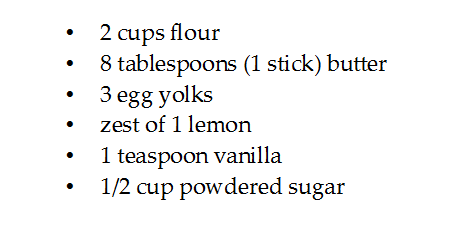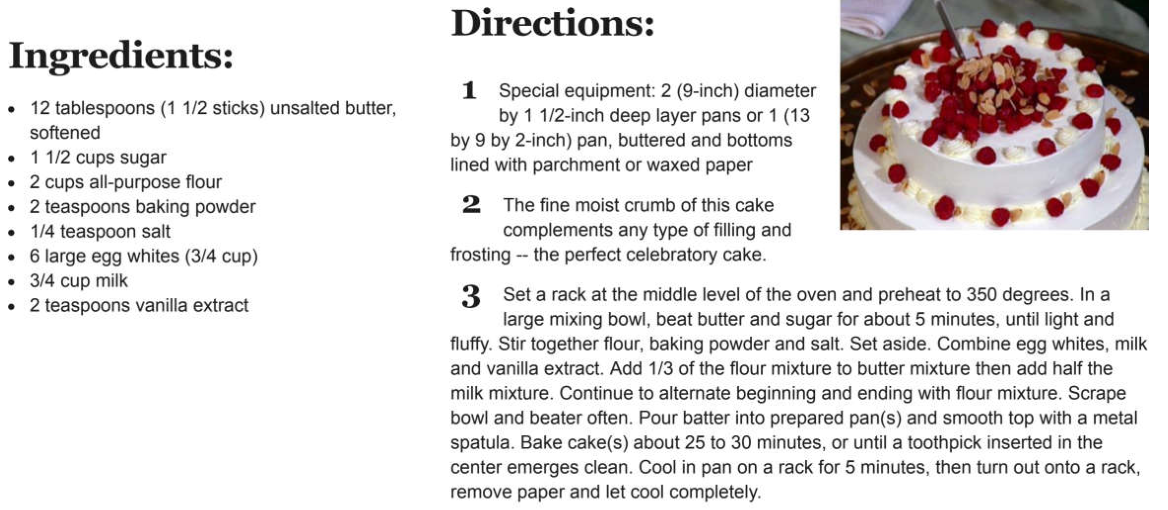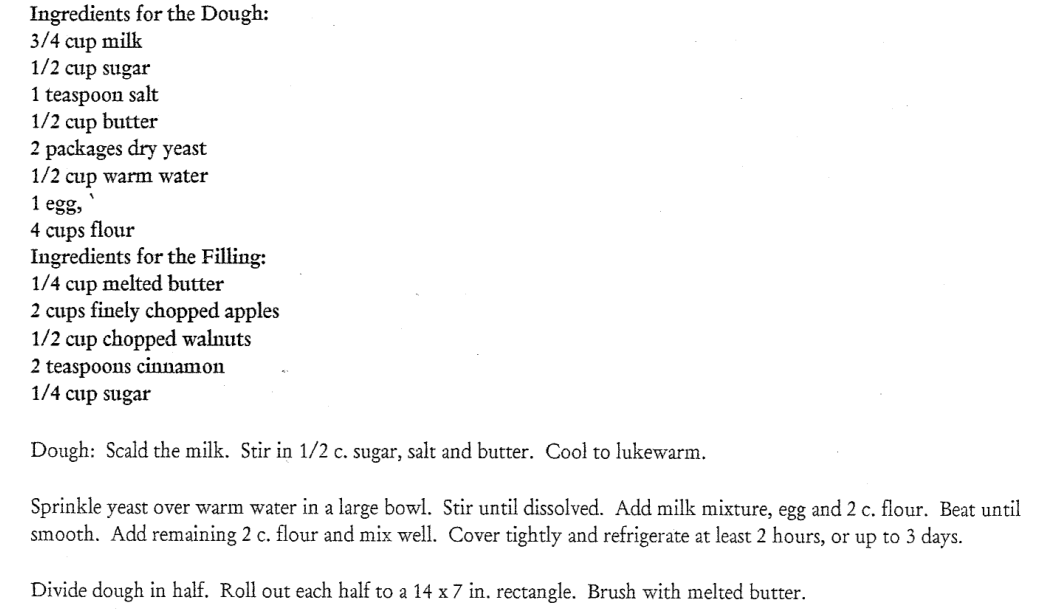January 2019
 In this post I’m going to pretend I’m on HGTV with my own show. I have a niche nobody ever thought of before: taking foreign recipes and making them look like they came from your American grandma. Why would I do a sneaky thing like that? Because most Americans in my ambit — and in yours, too, I’ll bet dollars to donuts — jump up from the table at the first mention of a foreign dish and make a beeline for the nearest Burger King. So we’re trying to expand those horizons at their unawares. Culinary forgery, that’s the name of our game. Sounds fun, right? Let’s get started.
In this post I’m going to pretend I’m on HGTV with my own show. I have a niche nobody ever thought of before: taking foreign recipes and making them look like they came from your American grandma. Why would I do a sneaky thing like that? Because most Americans in my ambit — and in yours, too, I’ll bet dollars to donuts — jump up from the table at the first mention of a foreign dish and make a beeline for the nearest Burger King. So we’re trying to expand those horizons at their unawares. Culinary forgery, that’s the name of our game. Sounds fun, right? Let’s get started.
I know the baselines because I grew up with Betty Crocker’s Picture Cookbook, which is actually a stand-in for grandma. It’s what you turn to if Grandma couldn’t find her way around in the kitchen or has the imagination of a ripe avocado. We have standards to maintain, girls, and a run to the deli counter won’t cut the mustard, so I’m bringing some spice into life in such a way that you can pass things off as Grandma’s without anybody being the wiser — provided you keep it zipped. What Grandma doesn’t know won’t hurt her and if you follow my lead it won’t hurt you, either. That’s the whole point.
Only one of my grandmothers qualified as a passable cook, but the only reason “passable” applies is because the culinary bar was set fairly low. I come from working-class stock on both sides, urban in its earlier phase and rural in its later one (where I entered the picture), so anything beyond salt and pepper as seasoning counted as exotic and words like “braise” or “julienne” would have elicited blank looks. Some years after my grandmother passed I helped my sister compile a family cookbook from the cards in her recipe box. A few titles from it will tell the story:
- Mrs. Hudson’s Meatloaf (Mrs. Hudson was a neighbor back in the day)
- Grandma’s Infamous Green Jello Salad (disfiguring meals every Thanksgiving and Christmas)
- Really Scary Molded Salad (no title, so I just made one up that seemed to fit)
- Hilda’s Nut Bread (from Great Aunt Hilda, Grandma’s sister)
- Zucchini Bread (nobody in the 1980’s in the States escaped this oily number)
- Chocolate Rapture Cake (from a brochure entitled “10 Cakes Husbands Like Best”)
That gives you an idea. The meatloaf recipe is typical. The flavoring agents for 2 1/2 pounds of ground beef consist of 1/3 teaspoon black pepper, 1/8 teaspoon garlic powder and half a cup of chopped onion. Yes, Bridget, garlic powder, Grandma didn’t have fresh garlic in the kitchen, are you nuts? What do you think we are, anyway, Italians? Jeez … Anyhoo, that amount of seasoning for that amount of meat means the recipe title should really be “Mrs. Hudson’s Baked Ground Beef.” It’s not going to get you into the final round of “Chopped,” trust me. I don’t remember ever having Chocolate Rapture Cake — if I had done I’d remember because it has a cup of coconut in it — and I never made it myself since I never had a husband who needed cheering up with a fab dessert because I went on a shopping spree with the credit cards. 🙂
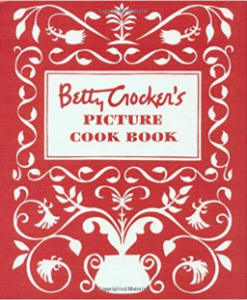 It’s no wonder given that repertoire that we found ourselves thrown back on my mom’s Betty Crocker cookbook to fill in the gaps. We used it mostly for baking, the main dishes coming from the standard repertoire of all middle-class cooks of the time: beef stew, lasagna, tuna and noodles — you know the drill. And of course as time moved on the Good Housekeeping and Woman’s Day recipes crept in, surprisingly enough especially in my grandmother’s case. Things like Turkey Enchilada Bake were as likely to come out of her kitchen as the old standbys. It made things more varied but not necessarily better.
It’s no wonder given that repertoire that we found ourselves thrown back on my mom’s Betty Crocker cookbook to fill in the gaps. We used it mostly for baking, the main dishes coming from the standard repertoire of all middle-class cooks of the time: beef stew, lasagna, tuna and noodles — you know the drill. And of course as time moved on the Good Housekeeping and Woman’s Day recipes crept in, surprisingly enough especially in my grandmother’s case. Things like Turkey Enchilada Bake were as likely to come out of her kitchen as the old standbys. It made things more varied but not necessarily better.
I took to cooking early on, to the point that I was putting on dinner parties as a teenager. I’ve cooked all my adult life since there usually wasn’t anybody else to do it. I’ve always thrown the gates open to cuisines from the entire world. So let’s pick a few recipes from foreign parts and Grandma-ize them. I’ll have more to say on the phenomenon later on. Fake family favorites coming up …
We’ll start with a main dish that’s German but has heavy Hungarian overtones to it. The original recipe is called Würzfleisch (spiced meat). As with so many German recipes the name does little to whet the appetite, it’s more like a coroner’s report on what died to make dinner possible. We’re going magically to transform this concotion into: Grandma’s Special Spiced Stew. I got the recipe from a German grandma who lived a couple doors down from me when I taught English over there, so it’s at least half legit.
![]()
Grandma’s Special Spiced Stew
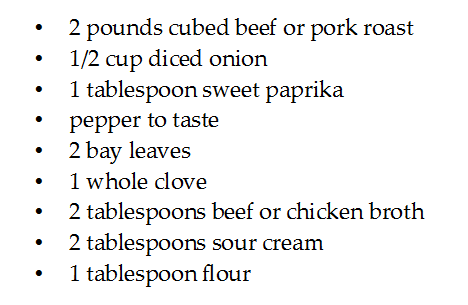
You can use beef, pork, a combination of beef and pork, or even chicken if you want. Up to you. Dust the meat in flour and sear it in a hot pan with a bit of oil until it browns, then set aside. Fry the onions (increase the amount if you want) in the same pan in butter — a tablespoon should do the trick — then put them into a pot with a good cover together with the browned meat. Add salt and pepper to taste, then the bay leaves, the whole clove, the paprika and the stock, the quantity of which you can increase if you want more sauce, but don’t overdo it or you’ll water everything down to be as boring as Mrs. Hudson’s Meatloaf. Bring the pot to a boil then braise the meat over low heat until it’s tender. Whisk the sour cream and the flour together until smooth. Take out about 1/4 cup of the cooking liquid from the pot and mix the sour cream/flour mixture into it slowly, whisking to make sure it’s smooth. Add the mixture to the pot with the meat and stir gently to combine, then increase the heat so the flour thickens the sauce, stirring all the while. Remove the bay leaves and the whole clove and adjust the seasoning to taste. Ready to serve! A dollop of sour cream and some sauteed mushroom slices on top make a handsome garnish.
The traditional accompaniment is mashed potatoes — but not like the ones you get at KFC. You need to do it right: use butter and milk (cream if you dare) and a goodly dash of nutmeg along with the salt and pepper. If you want you can serve it with wide egg noodles which will increase the Grandma factor considerably. If anybody asks you where Grandma got it from just say it came from a neighbor, Mrs. Hudson. 🙂
![]()
Grandma splashes out at holiday time, so we’re fobbing off this next recipe as one her Christmas specials. It’s another German recipe: Bienenstich (Beesting), an unusual case of a German recipe name taking a flight of fancy. You’d think there’s honey in it somewhere, but no, not a bit of it in the original recipe, so where the bee or the sting comes from is anybody’s guess. It’s a lot of work but hey, that’s what Grandmas do for the holidays, knock themselves out, right? Let’s get baking.
Grandma’s Holiday Honey Squares
Before we get into the particulars, let me say that I’ve modified this recipe so that it does indeed contain honey. We’re counterfeiting here but not doing false product advertising, so if there’s honey in the title there’s gonna be honey in what goes into your mouth. There are two parts, the sweet dough with the almond goo on top and the pastry cream in the middle. The dough needs to be a rich sweet dough, so I use this recipe intended for butterhorns:

While all the rising goes on you have time to make the topping that goes on the dough before baking. Use 1 cup granulated sugar, 1 cup butter and 1/2 to 1 cup sliced almonds. The butter and sugar get cooked together over medium heat until caramel-colored, then add the almonds and mix them in so they toast a bit. You can add a bit of cream to the cooked mixture if you like, but I like the clear color of the topping without it. Alternatively you can add a bit of light corn syrup to increase the volume and keep the texture soft if you want. Let the mixture cool to close to room temperature before you put it on the dough. Roll out the dough into a rectangle that fits on a baking sheet, keeping at least 1/2″ thickness, preferably 1″ if you can swing it. Distribute the almond mixture evenly over the dough, then into the oven it goes at 350F for about 20-25 mins. Bake just until done, it shouldn’t take on color because it needs to remain as soft as possible. Put the rectangle on a wire rack to cool after it comes out of the oven.
Now to the pastry cream filling. No need to get our knickers in a twist, Allrecipes has an easy pastry cream recipe (webpage here):
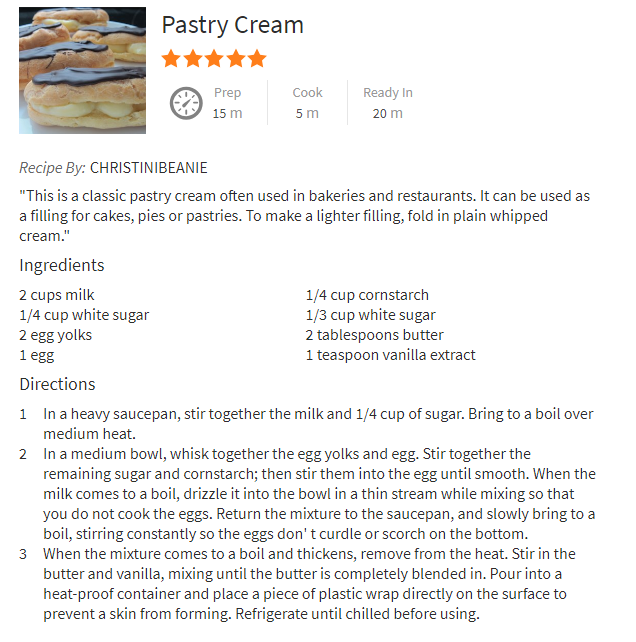
You want the pastry cream to be fairly stiff so increase the corn starch by a couple tablespoons if you want. Assembly is easy peasey. Slice the dough rectangle through the middle to get two halves, then cut into squares that seem the size your Grandma would use. Alternatively, cut the rectangle into squares first and then cut the squares in half through the middle, which is what I do so I don’t go into high anxiety trying to slice the big rectangle evenly. I go for squares about 3″ X 3″ but my Grandma was a big-boned gal so you can make them more petite if you want. Whip 1/3 cup of heavy cream with a bit of powdered sugar and a drop of vanilla (yes, Bridget, creme chantilly) and then fold it carefully into the pastry cream. This is an eyeball thing — you’re trying to lighten the pastry cream but not so much that it won’t hold its shape. If it’s too loose it will squish out the sides when you try to eat the squares, which will ruin Grandma’s reputation, so proceed with caution. After mixing in the whipped cream fold in 1 tablespoon of honey (“runny honey” if you’re a Brit) so you can’t be accused of false advertising. You can also add some grated lemon zest if you want, depending on what flavor package you’re after. If you want to gild the lily you can drizzle a bit of honey over the assembled square before serving and put on a topknot of whipped cream with a pinch of cinnamon dusted over it. Delish! Aren’t old family favorites just the thing for the holidays? 🙂
![]()
Grandmas and cookies go hand in hand, so we gotta have a cookie recipe in the mix. One of my favorites is Vanillekipferl, an Austrian cookie often made around Christmastime. Since we’ve got the holidays covered, we’re assigning this recipe to memory of the times when you popped over to Grandma’s for a visit and she hauled out the cookies, as she always did whenever anybody showed up. We wave our magic wand and suddenly they become: Grandma’s Half Moon Cookies.
Grandma’s Half Moon Cookies

The dough should be stiff, but not too stiff. Add the ground almonds first and then add the flour in increments until you get a firm dough that holds its shape but doesn’t go crumbly. Crumbly is the edge you don’t want to go over. Chill the dough, covered, for half an hour before shaping. The name of the recipe says it all. Take a teaspoon-sized ball of dough, shape it into a little sausage and then bend it into a half-moon shape. They go onto an ungreased baking sheet and into a 350F oven for 10-12 minutes until lightly golden brown. Cool them off but while still a bit warm waltz them in powdered sugar — if you’re posh, you can use powdered sugar in which you keep a piece of vanilla bean so the sugar takes on the vanilla aroma. Only do that if your Grandma was Episcopalian, however. If she was Baptist like mine, doing that sort of thing will get you found out as a fake in no time flat.
![]()
If you go to Grandma’s for dinner, you can count on there being a dessert brought to the table as soon as the main part of the meal is over. It just goes with the gig. My Grandma was big on pies, but they’re not as popular as they once were and nobody makes them at home anymore except bohunks like us who live out in the boondocks. So for the everyday dessert recipe we’re going to swipe something from Italy, a torta di ricotta that we’ll pass off as: Grandma’s Favorite Cheesecake.
Grandma’s Favorite Cheesecake
Grandmas do things from scratch, so we’re making the pastry crust ourselves, not buying a graham cracker crust from the supermarket, thank you very much. You can easily say you bought it if you want, up to you — if your Grandma was a corporate lawyer, go for it. This is the Italian pasta frolla of classic ilk:
The butter should be cold, not room temp. Work the butter into the flour by hand or with a pastry blender until it resembles crumbs, then add the remaining ingredients and mix until a dough forms. Turn the dough out and knead gently until smooth. Wrap it up in plastic wrap and refrigerate for one hour, then roll it out and place it in a springform pan. It’s ok to leave the top edge of the crust irregular if you’re of Italian descent. If not, even off that top edge with the edge of a spoon or you’ll make Grandma look like a slattern.
For the filling:
Combine the ingredients and mix just until smooth. Fill into the prepared pastry crust. Bake at 350F for about 30 minutes until the filling is set. Obviously the almonds are the texture element so strategize as you like — you can grind them if you don’t want any crunchy bits. The raisins are your ticket to moving around on the taste palette, believe it or not. Increase the quantity ad libitum. You can stew them in red wine and cinnamon, or use fresh ginger cooked in water and sugar as the plumping liquid — go crazy. Just make sure that whatever you choose is passed along as the way Grandma always did it, exactly as you learned when you helped her out in the kitchen. Don’t blow your cover! You can also do up the top with a layer of fruit preserve and fresh fruit — if it’s the 4th of July use sieved raspberry jam, fresh blueberries and a dollops of whipped cream and presto change-o: Grandma’s Patriotic Cheesecake. So clever with her hands, the old dear … Btw do NOT use low-fat ricotta. This is dessert, not something ingested as penance after going to confession.
![]()
Grandmas also do cakes, especially if it’s your birthday. Compared to European tortes, American cakes are pedestrian beyond words. All those fancy things you see in the glass case at Starbucks are not made with a box of cake mix and a tub of frosting from the supermarket, so don’t expect to imitate one of Grandma’s birthday cakes by going that route. Since we’re knee-deep in a stealth operation to masquerade as an American Grandma we obviously can’t be overdoing it with some fancy French or German torte, but fear not. I have the perfect thing: Grandma’s Banana Cake. It sounds like something from Good Housekeeping but I made it up. It’ll do the job to perfection, trust me, and it tastes fab.
Grandma’s Banana Cake
First the cake, obviously. Use a white cake mix if you must, just keep your mouth shut about it. The texture of cake from a boxed mix is a dead giveaway, so I prefer to make my own from scratch. The old Betty Crocker white cake recipe is complete crap. It uses shortening, not butter, and tastes like it was made with something drained off a crankcase. We’re ditching Betty and going to Nick Malgieri, one of the few reasonable TV bakers, for something worthy of Grandma (webpage here):
Now, for the filling. First, you need a batch of pastry creme, so use the recipe from the Honey Squares and increase the cornstarch by a couple tablespoons. We’re after a stiffer creme here because it needs to hold its shape, just like with the Honey Squares.
We’re also adding gelatin to the whipping cream so that it acts like frosting. Soften 1 to 1 1/2 teaspoons of granulated gelatin (use sheet gelatin if you want but mum’s the word, it’s too posh for Grandma) in 1/4 cup cold water until it’s completely dissolved. That accomplished, keep it handy to throw into the whipping cream as indicated below.
You’ll need plenty of whipped cream, so use at least two cups of liquid cream. Add a few tablespoons of powdered sugar and a splash of vanilla extract before you start beating. When the cream thickens enough to show the track of the beaters, add the dissolved gelatin in a steady stream with the beaters still on at lower speed, then once the gelatin is all in go back to high speed and whip until the cream forms stiff peaks.
Fold a few spoonfuls of the whipped cream into the pastry creme as you did for the Honey Squares but leave it slightly stiffer this time because it needs to hold its shape when you cut the cake, not squish out the sides. Slice 1 or 2 bananas, depending on the size, that are ripe enough to taste like bananas rather than potatoes but are still quite firm. Fold the sliced bananas into the pastry creme and spread it to make a nice, thick layer on top of the bottom layer of the cake, then nestle the top cake layer firmly over the filling and make sure the filling is smoothed off at the sides with no gaps showing. Cover the cake with an even layer of whipped cream.
Decoration depends entirely on Grandma. If she happened to be a lady-in-waiting to the Queen Mum, by all means feel free to get out the piping bag and the candied violets and push the boat out as far as you can row. My Grandma was solidly working-class, so simple is the only way to go. With bananas it’s not a good idea to use the fruit in the filling as part of the decoration — discoloration being the bugbear, of course — so I use sliced strawberries on the top to make a tasty decoration. Be creative but don’t push the envelope, okey dokey? We don’t want this to turn into Mission Impossible.
The cake should go into the fridge overnight if possible so it sets up properly. With the gelatin in the whipped cream it can come out at dessert time and hold its shape perfectly while people hack it to pieces. And trust me, they will, because it’s like having banana cream pie. Yum yum.
![]()
American grandmas are inevitably ethnic in one way or another — my grandmother who cooked halfway decently was of Swedish extraction. On the other side of the family things were nebulously English-Irish, but going back just a few generations put one into territory better left undocumented. Grandma usually has at least one ethnic recipe up her sleeve, so the trick here is to find something that will work across the boards. I have just the thing — something simple yet tasty that can be tweaked to fit all kinds of ethnic backgrounds. The recipe — crepas de champiñones — is Spanish, from the Basque country, but the filling can be modified to reflect any country you like. If you’re Polish, cook up a mixture of onion, crumbled sausage and herbs (maybe even a little sauerkraut into the mix). Greek? Ground lamb with mint, oregano and bechamel. You know what story you need to tell at the table, so build your filling and your alibi accordingly. For my version I’m flavoring things with dill, which will fake people out in a heartbeat, especially if I serve the crepes with beetroot/sour cream salad. Det smakar bra det där, likasom mormor brukade göra — that is to say: tasty, just like Grandma used to make.
Grandma’s Ethnic Crepes

Whisk the flour and salt together. Beat in the liquid ingredients to make a smooth batter, then let it rest in the fridge for at least one hour. Fry the crepes in butter — this recipe makes about 8, so if you have a big crowd to feed double or triple the recipe as needed.
For the filling, toss 4 cups of whole button mushrooms with a mixture of melted butter and olive oil in a mixing bowl, then spread them out on a baking sheet and season with salt and pepper. Roast the mushrooms in the oven at 350F for about 20 minutes. Cool them and then chop finely. To the chopped mushrooms add sauteed finely chopped onion (about 1/2 of one will do), fresh or dried dill to taste and 1/2 teaspoon dried marjoram that you pulverize between your palms before adding. Moisten the mixture with sour cream so it holds together nicely then fill the crepes, roll them up and put them into a buttered baking dish. Heat in a 300F oven until piping hot, then serve with a dollop of sour cream topped with a sprig of fresh dill. The Swedish Chef Hath Spoken.
![]()
Grandmas need something to trot out when it’s time to take something to a Church Basement Supper or the afternoon meeting of the Ladies Aid Society, depending on the context of the grandma. So we need something portable that will wow the crowd. We’re in luck. If you think back to the 80’s the words “bundt cake” may come to mind. It was all the rage. Companies like Betty Crocker and Pillsbury jumped on the bandwagon and sold bundt cake kits with the bundt pan and the mix bundled together. There were flavors of all sorts on offer — chocolate, lemon, lemon poppy seed, you name it. The bundt cake is actually of European inspiration, popular in both Germany and Austria. We can easily pilfer a classic Austrian Gugelhupf recipe and with a modest tweak we end up with : Grandma’s Apple-Nut Coffee Ring.
Grandma’s Apple-Nut Coffee Ring
First we get the dough started. Here are the ingredients:
Now comes the yummy stuff for the inside, ingredients given above. Here’s the procedure:
You can vary the filling however you like. If you’re Central European try the traditional poppy seed filling for something resembling Czech makový koláč. For something more British Isles try using lemon curd and ground almonds. Unless Grandma is seriously ethnic she’s not going to have the traditional Gugelhupf mould, which is like a bundt cake pan. But if your ethnic background makes it believable, by all means put your ring in a bundt pan and go for it. Up to you. But for heaven’s sake don’t say it’s a Gugelhupf, people will think you’re swearing and if there’s one thing Grandma did not have it’s a potty mouth.
To close we’ll use a real recipe from my very own Grandma, but you can steal it and say it’s from yours if you want. These lemon bars are the best lemon thing I’ve tasted in donkey’s years, so I’m passing the recipe on as it stands — with kisses from Grandma, of course.
Grandma’s Lemon Bars
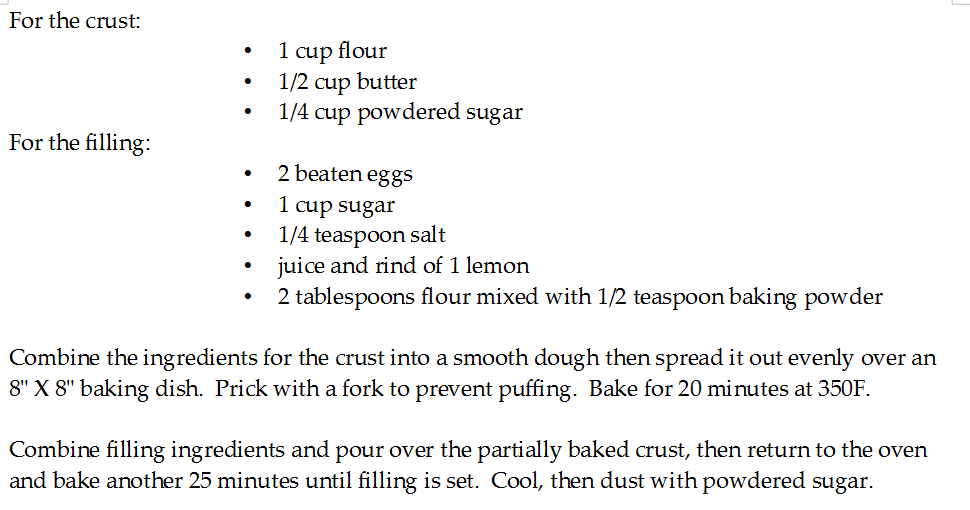
![]()
When I think about the standard American cuisine I grew up with, about the only thing it has to recommend it is that it kept body and soul together. Over the course of my adult life I’ve explored cuisines from many other parts of the world. For two years I cooked Indian food almost entirely, using Julie Sahni’s excellent cookbooks as my guide. The range of flavors in Indian food is fantastic, never a dull moment. I went whole hog and even made my own paneer and all the breads I could manage on the stovetop– unfortunately naan was beyond my reach because I didn’t have a tandoori oven.
After the Indian phase I went on to Italian, since I could get authentic Italian ingredients online and have them shipped right to my door. Italian food is somewhere between American and French cuisine — the focus on fresh and flavorful ingredients is the chief appeal along with the attention to coordinating flavors among the basic ingredients. I discovered tons of new favorites as I explored regional Italian cuisines. If the only thing you know from childhood as Italian is spaghetti and meatballs, it’s a revelation to see what really goes on in Italian kitchens.
Because I lived in Germany for two years German cuisine is familiar territory to me. I like it quite a lot. It takes a bad rap because people don’t know anything about the real McCoy. Say “German food” and Americans will think of a sausage and some sauerkraut. Real German cuisine is so much more. I think back on dishes like Jägerschnitzel (Allrecipes webpage here) or Kassler überbacken (German recipe webpage here) with fond memories. German pastries are fully the equal of those in French cuisine, in my opinion, and Austrian pastries are as good or even better. My homemade recipe book is full of German recipes that have become fast favorites and if I don’t tell people the dishes are German they’d never know.
Now that I’m retired my attitude toward cooking has changed and I’ve returned to the same adventurousness I had in my younger days. My attitude toward food has changed, as well. It’s no longer the utilitarian thing it always was when I was a working stiff, it’s become a part of life consider an element of good living. I have the time to be thoughtful about it and to do time-consuming dishes if I want, so I find myself returning to ways I gave up when my professional life made being in the kitchen something to get through with as little fuss as possible.
By trundling out yet another citation from Virginia Woolf I’ll doubtless make the eyes of any regular readers roll back in their heads, but they’re a miniscule population so I needn’t worry about causing a worrying spike in national health statistics LOL. Virginia has something very a propos to say about the matter of food in the essay I return to again and again, A Room of One’s Own, as she describes lunch at an Oxford college:
It is a curious fact that novelists have a way of making us believe that luncheon parties are invariably memorable for something very witty that was said, or for something very wise that was done. But they seldom spare a word for what was eaten. It is part of the novelist’s convention not to mention soup and salmon and ducklings, as if soup and salmon and ducklings were of no importance whatsoever, as if nobody ever smoked a cigar or drank a glass of wine. Here, however, I shall take the liberty to defy that convention and to tell you that the lunch on this occasion began with soles, sunk in a deep dish, over which the college cook had spread a counterpane of the whitest cream, save that it was branded here and there with brown spots like the spots on the flanks of a doe. After that came the partridges, but if this suggests a couple of bald, brown birds on a plate you are mistaken. The partridges, many and various, came with all their retinue of sauces and salads, the sharp and the sweet, each in its order; their potatoes, thin as coins but not so hard; their sprouts, foliated as rosebuds but more succulent. And no sooner had the roast and its retinue been done with than the silent serving-man, the Beadle himself perhaps in a milder manifestation, set before us, wreathed in napkins, a confection which rose all sugar from the waves. To call it pudding and so relate it to rice and tapioca would be an insult. Meanwhile the wineglasses had flushed yellow and flushed crimson; had been emptied; had been filled. And thus by degrees was lit, half-way down the spine, which is the seat of the soul, not that hard little electric light which we call brilliance, as it pops in and out upon our lips, but the more profound, subtle and subterranean glow which is the rich yellow flame of rational intercourse. No need to be anybody but oneself. We are all going to heaven and Vandyck is of the company — in other words, how good life seemed, how sweet its rewards, how trivial this grudge or that grievance, how admirable friendship and the society of one’s kind, as lighting a good cigarette, one sunk among the cushion in the window-seat.
Maybe with your Grandma the bit about “rational intercourse” obtained as a matter of course. I assure you there was no question of any such thing with mine, since “rational” is the least likely word to describe her. She did have the Grandma shtick down pat, however, because she created that sense of sufficiency and ease from her kitchen that a proper grandma purveys, with a resource base that was never very large and in the earlier days required some skill in stretching from end to end. But as a product of the American working class she was entirely typical in the way she cooked. Being adventurous in the kitchen meant trying out a new recipe from Woman’s Day, not grinding the spices for her own garam masala. All the same, credit is due her for consistently giving us grandkids the sense of plenty that all of us associated with her kitchen.
I abandoned working-class cuisine as soon as I left home. It’s been yonks since I had beans and weiners (thank God) and if luck is with me I’ll end my days without ingesting it again. I became a much better cook than my Grandma ever was because I was restless in the kitchen, always looking for new things from other parts of the world to add to my humble culinary foundations. If you open yourself to ethnic cusines all manner of delights become available and the challenges in the kitchen never stop. For example, I love Thai food to death but have no idea how to cook it authentically. That’s a voyage of discovery on which I have yet to launch my ship. Now that I have the time to tackle learning it, I’ll head into that unexplored territory sometime soon, I’m sure.
But we all have times when we need a good old Grandma’s favorite. If like me the Grandma recipe box yields slim pickings and you don’t want to bore either yourself or your guests to death, give these fake ones a try. I think you’ll find they improve Grandma’s reputation as well as your own — as long as you know how to keep a secret. 🙂

